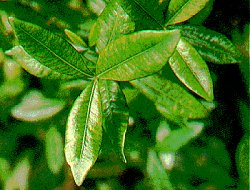 Maire |
Mauke - East of Eden
by John Walters, July 1999
MAUKE is half as big as Rarotonga in circumference. It is 18 kilometres (11¼ miles) around compared to Rarotonga's 32 kilometres (20 miles). The topography, however, is quite different. Mauke consists of a central volcanic plateau which climbs to a maximum height of about 30 metres. It is surrounded by a raised, fossilised coral reef – 'makatea' – which ranges from about 100 metres from the shoreline to about 1000 metres inland. There are no rivers so rainwater which falls inland drains into swamps on the inner rim of the 'makatea' and thence underground to the lagoon, similar to Mangaia. The lagoon is very short and you get a good close-up of spectacular waves smashing on the surrounding reef.
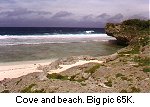 | 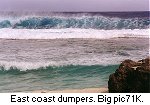 |
There are no sealed roads; they are topped with crushed coral sand, much like Rarotonga's roads in the 1950s before the advent of international jets, resort hotels and tourists. As in Aitutaki, there are no dogs. However, wild pigs are prolific. Even the ubiquitous wild roosters are well adjusted compared with their dysfunctional cousins in Rarotonga who start crowing at 10pm and go right through the night as well as most of the next day.
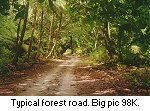 | 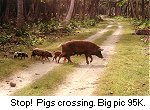 |
Mauke is a garden island, extremely verdant and fertile with magnificent hardwood trees in its interior. These forests are where the 'maire' bush is found growing wild,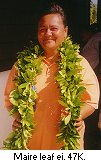 the source of a thriving export industry to Hawai'i where the leaves are used to make welcoming 'leis' – garlands. Each week, the island gets an order from Hawaii and the women head into the interior at the weekend to pick enough 'maire' leaves to be airfreighted out on Monday.
The village roads are tidy and well-maintained with low white coral walls at the front boundary of the houses. On the way in from the airstrip at the north-west corner of the island the first village is Kimiangatau.
Just before the small hospital lies the derelict house of Julian Dashwood, the flamboyant English writer who arrived in the Cook Islands in the 1930s.
He worked in Mangaia and Manihiki and eventually moved to Mauke where he married a local girl and ran a store.
the source of a thriving export industry to Hawai'i where the leaves are used to make welcoming 'leis' – garlands. Each week, the island gets an order from Hawaii and the women head into the interior at the weekend to pick enough 'maire' leaves to be airfreighted out on Monday.
The village roads are tidy and well-maintained with low white coral walls at the front boundary of the houses. On the way in from the airstrip at the north-west corner of the island the first village is Kimiangatau.
Just before the small hospital lies the derelict house of Julian Dashwood, the flamboyant English writer who arrived in the Cook Islands in the 1930s.
He worked in Mangaia and Manihiki and eventually moved to Mauke where he married a local girl and ran a store.
Dashwood wrote sensitively and evocatively about the Cook Islands in magazines and books('South Seas Paradise') under the pseudonym Julian Hillas. He later had a short but eventful career as a Minister in the first Cook Islands Government in the 1960s, but resigned after being convicted on corruption charges. He died shortly afterwards in 1970. His grave lies beside his wife's, Kopu, in the garden behind the house, close to the road.
The spacious house is now a ruin, the half-acre garden overgrown with weeds. The high-ceilinged rooms contain remnants of furniture, a wind-up gramophone, bedsteads and small cupboards.
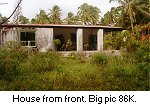 | 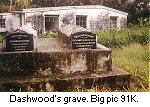 |
It is not hard to imagine, however, what the homestead would have looked like in its heyday in the 40s and 50s. Rows of huge hibiscus bushes surrounded by cropped green lawns and the massed flowerbeds blazing with color under the big, shady trees. Here Dashwood would have entertained his guests and played the role of lord of the manor in the South Seas.
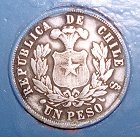 Near the junction of Ngatiarua and Areora villages is the huge Zion church which is Mauke's largest and most idiosyncratic structure. The Maukeans call it the 'divided church' because it was built as a place of worship to be shared between two villages. The pulpit is in the centre of the huge nave and the congregation sits on whichever side has been designated for them.
At the front of the pulpit, which is in a low railed enclosure, are embedded nine silver Chilean coins which were common currency in the central Pacific in the nineteenth century. Often referred to wrongly as Chilean dollars, there are eight Chilean pesos dated between 1870 and 1881. The ninth coin is an unidentified 'sol' with the inscription: 'Firme y Feliz por la Union'.
Near the junction of Ngatiarua and Areora villages is the huge Zion church which is Mauke's largest and most idiosyncratic structure. The Maukeans call it the 'divided church' because it was built as a place of worship to be shared between two villages. The pulpit is in the centre of the huge nave and the congregation sits on whichever side has been designated for them.
At the front of the pulpit, which is in a low railed enclosure, are embedded nine silver Chilean coins which were common currency in the central Pacific in the nineteenth century. Often referred to wrongly as Chilean dollars, there are eight Chilean pesos dated between 1870 and 1881. The ninth coin is an unidentified 'sol' with the inscription: 'Firme y Feliz por la Union'.
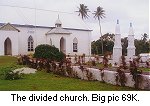 | 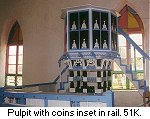 |
The central south area of Mauke is quite open. If it were not for the occasional coconut palm, the landscape could almost be rural European. The old airstrip was in the interior and the tropical hardwoods which previously flourished there were cleared to make way for the runway. Now it looks like an overgrown paddock and cattle graze on it.
Mauke has a special atmosphere. Its people cleave to the old customs of hospitality – the 'ui tupuna' – and they are very friendly to visitors. People from overseas need to adjust to a different pace and style. There is a tradition on Christmas Day peculiar to Mauke only when people go from to door in the villages singing traditional songs. Shops are few and far between, are often closed and the range of goods on offer is limited. There are no cafés or restaurants, milk has to be bought in powder form in cans and fresh home baked bread comes from an old gentleman in Ngatiarua village who bakes loaves in a wood-fired oven.
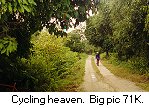 Probably the best way to explore Mauke is by rented bicycle. The coral roads are deserted and peaceful. A day spent cycling slowly round the circumferential road is an absolute delight. The road curves gently through the coconut palms and hardwood trees. Every so often a small, sandy beach comes in sight bordered by rocky outcrops.
Probably the best way to explore Mauke is by rented bicycle. The coral roads are deserted and peaceful. A day spent cycling slowly round the circumferential road is an absolute delight. The road curves gently through the coconut palms and hardwood trees. Every so often a small, sandy beach comes in sight bordered by rocky outcrops. 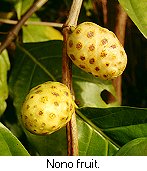 In the vegetation bordering the track you will find growing wild the 'nono' tree whose fruit is now the darling of the health food industry in the USA and is being touted as a cure-all for every imaginable ailment. Also called the Indian mulberry, it is an ancient Cook Island herbal medicine. Its botanical name is Morinda citrifolia.
In the vegetation bordering the track you will find growing wild the 'nono' tree whose fruit is now the darling of the health food industry in the USA and is being touted as a cure-all for every imaginable ailment. Also called the Indian mulberry, it is an ancient Cook Island herbal medicine. Its botanical name is Morinda citrifolia.
Mauke has an impressive pre-history. There are at least 11 sites which could be described as 'marae'. This word has a different meaning to its counterpart in New Zealand. In Mauke it refers to a ceremonial structure similar to those found in eastern Polynesia. Usually, 'marae' contain prepared structures with paving, stone walls or platforms and have a 'tapu' or sacred quality. On Mauke the word applies to sites associated with ancestors. However, the people did not build the same type of large stone structures found elsewhere in the southern Cooks and in Tahiti and the Society Islands.
There is professional accommodation at the Tiare Holiday Cottages. The Tiare has five studio units with shared bathroom, cooking and tea/coffee facilities. Meals are available for guests in a separate dining hut. As with other southern group islands, power is switched off around 10.30pm until 6am so a flashlight and spare batteries are recommended. A guided trip to the spectacular caves and beaches (not really for swimming though) is well worth while.
Air Rarotonga flies regularly to Mauke.
Accommodation details are at: Accommodation on outer islands
Back to Mauke - Geography.